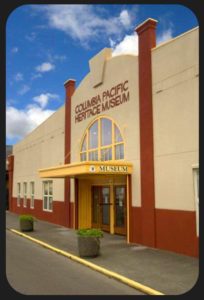| 1874 |
- Lewis Alfred Loomis and partners formed the Ilwaco Wharf Company then built the wharf in Ilwaco.
|
| 1875 |
- L.A. Loomis reformed the group into the Ilwaco Steam Navigation Company, and built the steamer GENERAL CANBY.
|
| 1881 |
- L.A. Loomis formed the Shoalwater Bay Transportation Company and built the two steamers, the GENERAL MILES and the GENERAL GARFIELD.
|
| 1882 |
- L.A. Loomis started to raise the money to build a railroad up the historic North Beach Peninsula. His partner was Jacob Kamm of Portland, a mariner engineer, banker and promoter. The project’s unofficial name was the Ilwaco, Shoalwater Bay & Grays Harbor Railroad.
|
| 1884 |
- A survey of the line was done by Major A. F. Searles, the cost was estimated to be $15,000. a mile.
|
| 1887 |
- The final route survey was completed by Harvey Pike.
- L.A. Loomis purchased the right-of-way.
|
| 1888 |
- Construction of the railroad began in Ilwaco in March, starting with the engine shed, shops, turntable and water tank. Rolling stock was then purchased from other narrow gauge railways.
- With 3½ miles of track laid by mid-July, the first train ran to the community of Long Beach.
- Reorganized in August, the company became the Ilwaco Railway & Navigation Company.
|
| 1889 |
- At a length of 13½ miles, the North terminal of the railroad was at Nahcotta on Shoalwater Bay. A dock, depot, turntable and machine shop were built there.
- Jacob Kamm traveled to Chicago, IL to purchase one passenger coach from the Pullman’s Palace Car Company. Today, the NAHCOTTA, or N10, is in the courtyard of the Columbia Pacific Heritage Museum. Kamm also purchased six flatcars from Pullman.
|
| 1890 |
- Kamm purchased three passenger coaches and a combination car from Jackson & Sharp Company. Second-hand rolling stock was also acquired.
- Regular train service began based not on a time table, but on a tide table.
- Conductors and trainmen didn’t have uniforms.
- The railroad carried the mail, passengers and freight.
- Tuesday was oyster day, when about 1,000 sacks (80lbs. each) of oysters were carried from Nahcotta to Ilwaco for .75¢ per sack.
- Freight included canned clams from Ocean Park and cranberries from the bogs.
- A second locomotive was purchased.
- Most of the crew lived in Nahcotta or Ocean Park.
|
| 1892 |
- Kamm built a sternwheeler, the OCEAN WAVE, for the Portland to Ilwaco run.
|
| 1895 |
- The only fatality on the railway occurred on August 18th, when crewman David Hinman’s handcar was hit by a train while in dense fog.
|
| 1898 |
- The OCEAN WAVE was sold to be operated in San Francisco.
|
| 1899 |
- On May 22nd, a section of the Ilwaco wharf collapsed causing several cars to fall in to the water.
|
| 1902 |
- A logging dock was added in Nahcotta.
- A number of “log buggies” were added to the rolling stock.
|
| 1903 |
- Loomis sold the railway to the Oregon Railroad & Navigation Company for $142,000.
- Air brakes and knuckle couplers became standard equipment.
- The crew was now required to wear uniforms.
- New depots were built in Seaview and Long Beach.
|
| 1905 |
- Edward Budd became superintendent, and coined the phrase “Clamshell Railroad.”
|
| 1906 |
- The Columbia Valley Railroad Company was contracted to build an extension of the line from Ilwaco to Megler on the North shore of the Columbia River, about a mile East of Point Ellice, with an additional 13.4 miles of track. The new rail would be 90lb. Replacing the 60lb rail in the old section. The cost would be $280,000.
|
| 1907 |
- Over 400 men were employed on the Megler Extension project that included building a tunnel under Fort Columbia, and adding a large dock, train shed and turntable out at Megler. Improvements also included: a new depot and four-stall roundhouse at Nahcotta; sidings at Ilwaco, Long Beach and the Breakers; and a water tank at Holman.
|
| 1908 |
- The rails of the East extension reached Chinook in April.
- The first train ran from Megler to Nahcotta, the trip took 3 hours, the fare was $1.25.
- An oil storage tank was built at Megler for the three oil burning locomotives, with an emergency tank in Nahcotta.
|
| 1909 |
- On Summer weekends, the side-wheeler T.J.POTTER, was used by many Portland-based men to visit their families on the North Beach Peninsula. This became known as “The Husband Special” or “The Papa Train.” The fare from Portland to Nahcotta was $4.75.
|
| 1913 |
- Lewis Loomis died in his home and is buried in the Oysterville cemetery.
|
| 1915 |
- All rolling stock and locomotives were marked with the name of the parent company, Oregon-Washington Railroad & Navigation Company, which was owned by the Union Pacific.
|
| 1921 |
- Students began riding the train to class at the new consolidated high school in Ilwaco.
|
| 1930 |
- The last train ran September 9th. All rolling stock was either sold or scrapped. A number of passenger coaches were sold to be used as cottages, one went for $50.00. Most of the track was pulled-up and sold, ending up in China.
|
